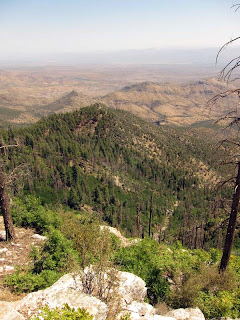It's been an entire week since I fully intended on updating my blog. And I've even been outside twice in the past week, otherwise glued to the computer screen, studying up on Oregon geology, or scrubbing my neglected kitchen. My friend Nick Acheson puts me to shame with his delightfully relentless updates to his Compare the Marsh Tit blog http://comparethemarshtit.blogspot.com (which I'm still catching up on, only up to mid-February now). Not to mention his spotless kitchen.
So last Thursday I boarded my 1991-vintage Bridgestone City Limits bike, and road in the not-so-fresh pre-dawn 80°F summer heat at 6:30 a.m. for 12.2 miles to meet up with my friend Mary Klinkel for some butterflying up the Catalina Highway. Apache Scrub Cicadas (Diceroprocta apache) were already drowning out all other environmental sounds with their incessant, sizzling buzz, but I did notice a Peregrine Falcon along the way.
Mary surprised me with a little diversion before we were to reach our high-elevation butterflying destination: she had been given an Ursine Giant Skipper pupa that had emerged last night and required releasing. In a big jar was the little giant.
So about halfway up the mountain, we released it, but the sluggish creature posed for photos before lumbering off. I've always wondered why the Kaufmann-Brock field guide printed that one plate of Megathymus in black-and-white, but now I understood that it's the whole genus that decided on the the dichromatism. I even set my camera to take a photo in BW mode for comparison, and there's little difference in the foreground subject. I think there's a PhD in the waiting here, investigating how different groups of animals perceive color. Or not. Or not.
We got to Incinerator Ridge (8000 feet elevation) at about 8:45 a.m. and it was already busy with insect activity. Our primary focus was the masses of blooming buckbrush (Ceanothus fendleri) that apparently has a delightful nectar, despite the insignificant, foul-smelling flowers.
And it was a delightful morning at this elevation, fabulous view to the south, looking over the Tucson metro area…
…and looking north over expanses of Pinal County's Sonoran desert.
We saw a total of 23 species of butterflies in our 2 hours here. One of our most hoped-for butterflies was also one of our first: this gorgeous Colorado Hairstreak. It's a giant among US lycaenids, and the upper side is a stunning iridescent purple.
Another beauty which abounded here (we saw maybe 15) is the Arizona Hairstreak, unusual in not having the normally requisite hindwing tails of the hairstreak subfamily.
Perhaps the most abundant butterfly here was the Southwestern Azure (formerly Spring Azure), probably because its main caterpillar host plant here is the very buckbrush.
I spotted but one Leda Ministreak. Closer to its host plant, Velvet Mesquite, it can be incredibly abundant.
There were quite a few duskywings, but the only one I could ID for sure was Mournful Duskywing.
Taxiles Skippers were pretty common – this one is a female.
And this is a male Taxiles Skipper. Not many skippers are so sexually dichromatic.
Nais Metalmark was scarce when we arrived, but by 10:30 they were everywhere. This one did me a favor by settling on one of my favorite plants, a milkweed. This is Asclepias hypoleuca, the Mahogany Milkweed.
The buckbrush flowers must be irresistible. The numbers of diptera and hymenoptera were unbelievable. I managed a photo of this one beefly (family Bombiliidae, perhaps a Villa sp.).
Two species of raptorial robberfly were taking advantage of the smorgasbord of pollinators. This tiny one less than a centimeter long…
...and this giant of about 3 centimeters.
Spider wasps (family Pompilidae), despite their gruesome life history, freely enjoy the nectar high.
A few nice flowers posed – this a Penstemon barbatus. While I did hear a few Broad-tailed Hummingbirds zing past, their distinctive wing noise unmistakable in flight, none stopped to feed here.
And this is an Indian paintbrush, Castillea austromontana, probably the host plant for the very local Black Checkerspot, of which we saw just one.
Of course there were birds. I took a moment to mimic Mountain Pygmy-Owl and was rewarded almost instantly with a maniacal mob of House Wrens, Pygmy Nuthatches, Yellow-eyed Juncos, Hairy Woodpeckers, and others. I managed to digibin (with my camera held up to my binoculars) this Olive (not a) Warbler with an Audubon's Yellow-rumped Warbler posed in the background.
Back at our rendezvous spot, it was already over 100°F, soon to be the day's forecast of 106°. I biked just 2.5 miles this time – to the nearest and easternmost bus stop this time of day – and had great luck to meet the bus that was staging for a couple minutes before its scheduled departure.

























No comments:
Post a Comment